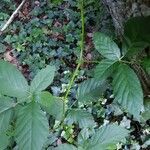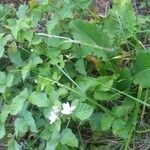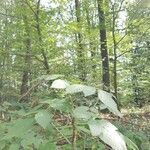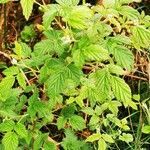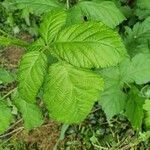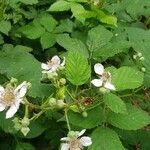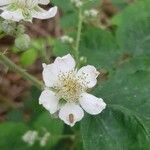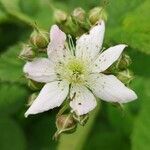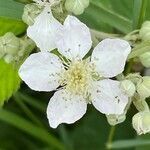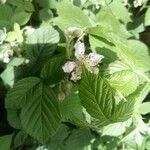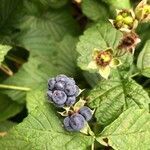Shrubs, to 3[–10] dm, armed. Stems ?biennial?, creeping or arching then creeping, glabrous or hairy, eglandular or sparsely sessile-to short-stipitate-glandular, strongly pruinose; prickles sparse to dense, erect to retrorse, slender, 1–3 mm, narrow-or broad-based. Leaves deciduous, ternate; stipules linear-lanceolate to ovate, 5–15 mm; terminal leaflets ovate, 4–14 × 3–10 cm, base rounded to shallowly cordate, unlobed or shallowly lobed, margins coarsely serrate to doubly serrate, apex acute to acuminate, abaxial surfaces with prickles on midveins or unarmed, sparsely to moderately hairy, eglandular or sparsely short-stipitate-glandular along larger veins. Inflorescences terminal ?on short shoot, usually appearing axillary?, 1–6-flowered, solitary flowers, cymiform, or racemiform. Pedicels unarmed or prickles sparse to dense, erect to retrorse, densely hairy, sparsely to densely sessile-to short-or long-stipitate-glandular. Flowers bisexual; petals white, obovate to elliptic or suborbiculate, 7–13 mm; filaments filiform; ovaries glabrous. Fruits appearing bluish, black beneath bloom, ?pruinose?, globose, 0.5–1.5 cm; drupelets 1–5(–20), weakly coherent, separating with torus attached. 2n = 28.
Primocanes ascending, soon arched and rooting at the tip, sparsely beset with stout hooked prickles with expanded base, not bristly, glaucous when young, primocane lvs 3-foliolate, the lfls broadly ovate, subcordate at base, softly pubescent beneath; infl subpaniculiform, some of its axillary branches with 2 or more fls. Native of Eurasia, occasionally escaped from cult.
A plant which trails over the ground. It grows 0.6-1.2 m high and spreads 1.8-3.5 m wide. The stems have a few prickles. The leaves have 3 leaflets and they are slightly downy. They have teeth along the edge and have an aroma. The leaflets have 2-3 lobes. The flowers are large and white. The fruit are black berries. They are edible.
